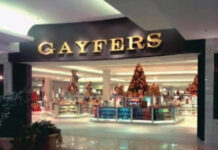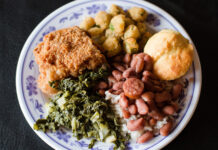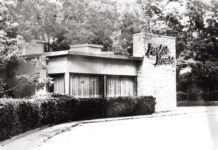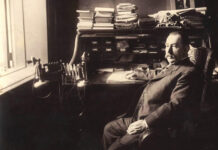
This was a dependency beyond the service wing of a house that once stood at 351 St. Michael Street on the south west corner of Claiborne. According to research done as part of the Historic American Buildings Survey in the 1930’s that house dated to 1842 and was built by John Van Wanroy.
Van Wanroy had been born in Amsterdam in 1801, arriving in Mobile at the age of 19. He married the widowed Gertrude Tankersely in 1842, and apparently built the house on St. Michael Street soon after. In addition to being a widow, Gertrude was the daughter of Antonio Espejo, an early Spanish settler of Mobile who had acquired extensive land grants before his untimely death from yellow fever in 1805. Espejo Street was later named in his honor and Catherine Street honors his widow, Catalina.
The Van Wanroys had no children, but resided here with Gertrude’s two daughters, Gertrude and Caroline Tankersley. Van Wanroy was a commission merchant and in 1845 became a director of the Merchants Insurance Company, offering “Insurance against loss or damage by FIRE and against the hazards of marine and river navigation.” He would later serve as consul to the Netherlands.
No More Desirable Dwelling in the City
John Van Wanroy died in 1875 and Gertrude later put their home on the market. An 1878 ad in the Mobile Register described it as “The premises known as the Wanroy Place, bounded by St. Michael, Claiborne and St. Francis streets. The dwelling has three stories and a basement. The yard is large, out houses commodious and ample, large underground cisterns and a well of good water. The place is enclosed by a substantial and well-built brick wall. There is no more desirable dwelling in the city.”
It is not clear who purchased the house but in 1890 it was home to Gabriel Jacobson, his wife Rebecca and their five children. Jacobson was a partner in Brisk and Jacobson which advertised itself as both a manufacturer of clothing and “Wholesale and Retail Dealers in Gent’s Furnishings.” The business was located in the building which still stands at the south west corner of Dauphin and Water streets with its distinctive cast iron façade.
Rebecca died in 1914 and four of her adult children would live here for several more years. The neighborhood was rapidly changing beyond that substantial brick wall. The house had once been within a short walk to the city’s oldest Baptist and Jewish congregations. Both had moved out by 1907 and the Baptist church building had been converted to a Scottish Rite Cathedral while the former Temple housed an auto repair shop.
Mansions along nearby St. Louis Street became boarding houses before the wreckers arrived. Car dealerships multiplied. A new Scottish Rite Cathedral towered beyond the former stable wing by 1921.
Number 351 St. Michael remained residential and its widowed owner took in lodgers until 1945. The following year it was listed in the city directory as being vacant, while across the street stood a parking lot beside the mammoth home of the Southern Bell Telephone Company.
The block to the east held an auto repair shop, a machine shop and a sheet metal dealer. In the midst of all that and surely the oddest was a listing for Mrs. Malvina Clinton’s “Sure Shot Laboratories –
A Toilet Preparation Manufacturer.”
A Survivor – For a While
Perhaps because the big house was so well constructed, it survived as office space. In the 1947 directory, the Gulf Coast Wired Music Company was operating at this address offering “Music by Muzak – Wired Music for Hotels, Stores and Restaurants.” Two chiropractors named Davis also shared the address.
By 1953, the offices of Edmund deCelle, a Mardi Gras scenery and costume designer, could be found here along with a chiropractor named Gully and the union headquarters for the Communication Workers of America. There was also an architect’s office within as well as an advertising firm.
According to the Sanborn Fire Map, while the house was classified as office space, the wing which had held the stables was a storage building for a contractor. The sole occupant of the address in 1959 was the Grain Division of the U.S. Department of Agriculture. The address is then listed as vacant and number 351 disappears entirely from the 1963 city directory.
The house that had survived for 120 years was razed. Its bricks were probably hauled off to west Mobile to build patios and houses in new subdivisions. Today only the former service wing and stables survive shorn of that substantial well-built wall. It currently houses The Stables Bar.






